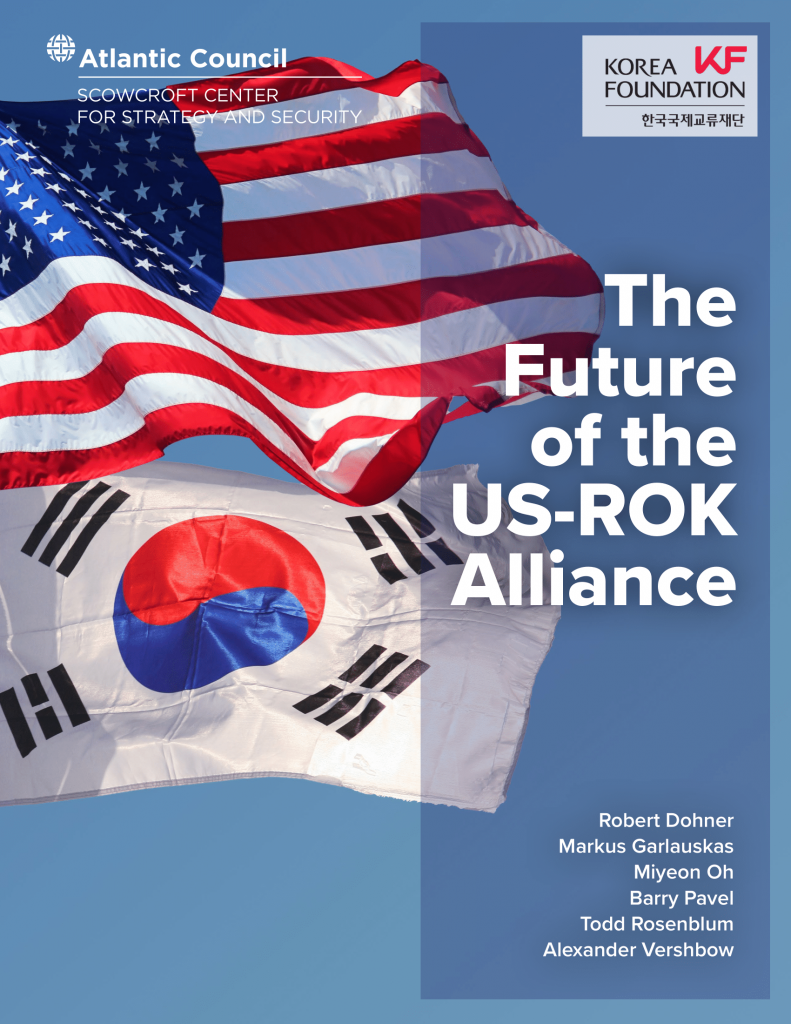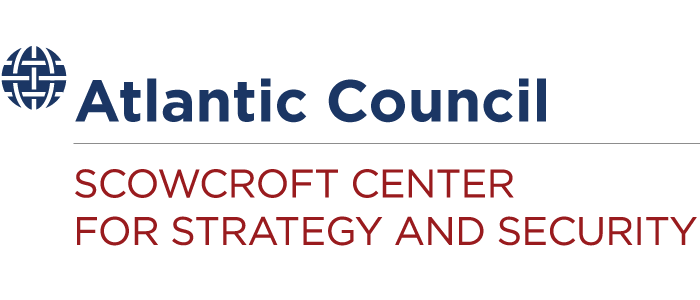Report release: The future of the US-ROK alliance

As the 2020s open with a global pandemic, an enduring North Korean threat, and the continued rise of China, the US-ROK alliance faces perhaps the most complex strategic environment in its seven-decade history. To meet the range of security, political, and economic challenges in the decade ahead, the United States and Republic of Korea must develop a vision for the future of their alliance that accounts for this rapidly evolving environment. This will include the need to define an integrated strategic vision for the post-pandemic Indo-Pacific, innovate new ways forward for denuclearization efforts, and adapt the alliance’s security and economic relationship to a rising China.
This report by the Scowcroft Center for Strategy and Security’s Asia Security Initiative, The Future of the US-ROK Alliance, provides an actionable roadmap for the Biden and Moon administrations, including key recommendations for the alliance’s strategic role on the Korean Peninsula, across the Indo-Pacific, and around the world.
Executive Summary
1. A New ‘National Security Alliance’: Re-setting the US-ROK Alliance for the Pandemic Era
In chapter one, Barry Pavel, senior vice president and director of the Atlantic Council’s Scowcroft Center for Strategy and Security, argues for the importance of adapting the long-standing alliance to address a dramatically changing operational landscape.
To prepare the alliance for a post-pandemic world, Pavel recommends that the alliance:
- Launch a joint strategic assessment in the aftermath of the COVID-19 pandemic that seeks to understand the core implications of the virus for national security and for the future of the US-ROK alliance and combine it with an updated assessment of the geopolitical and security situation on the peninsula, in the region, and globally;
- Develop a new national security concept to anchor the alliance, based on the recognition that 1) citizens in democratic societies will only support their governments’ national security policies and budgets to the extent that they help protect them from pandemics as well as other major security threats, and 2) only through an integrated orchestration of national tools combined with the same from allies, harnessed by a coherent, comprehensive, long-term strategy, can a broad-based, sustained challenge of the magnitude and breadth of that posed by China be handled skillfully and, ultimately, successfully;
- Pursue enhancements in alliance military capabilities geared toward increasing the ability of the alliance to handle North Korean threats of coercion, aggression, and implosion, including the specific threats of nuclear weapons launched by ballistic missiles as well as biological weapons use;
- Take actions to address the Special Measures Agreement by working to conclude negotiations as soon as possible while conducting discussions in a structured and predictable way so as not to undermine the strength and durability of the alliance; and
- Initiate next steps on the operational control (OPCON) transfer path by continuing to aim for a conditions-based transition to the Republic of Korea.
To build out the alliance for US-China geopolitical competition, he also argues that the allies should:
- Diplomatically lead the world to ensure that a “China First” global system does not come to pass by helping arrange new groupings of democratic nations to strengthen coordination among them across the key domains of the geopolitical competition including technology and the economy;
- Level the economic playing field, including doing much more to reduce dependence on Chinese supply chains and protect key industries from predatory Chinese practices while avoiding suggestions of complete de-coupling from China;
- Set effective technology standards by allying together with the other leading democracies comprising the so-called “D-10”—Australia, Canada, France, Germany, Italy, Japan, the United Kingdom, plus the European Union—to promote standards for secure 5G across the democratic world and beyond;
- Model democratic values of constructive democratic discourse and vibrant civil societies, freedom of speech and of the press, and the right of assembly, and other basic rights of democratic citizens; and
- Prepare to prevent and mitigate future pandemics by linking efforts of US and ROK governments and scientific and medical communities together to play a leading role both in the near term in a global “Counter-Coronavirus Coalition” and in the longer term on protecting the world from future pandemic threats in coordination with leading democracies.
2. The Future of the US-ROK Economic Partnership
In chapter two, Dr. Miyeon Oh, director and senior fellow of the Scowcroft Center’s Asia Security Initiative, and Dr. Robert Dohner, nonresident senior fellow of the Asia Security Initiative, begin by arguing that the Indo-Pacific region is now facing a new geopolitical and geoeconomic environment characterized by three elements: 1) US-China strategic competition; 2) a changed view of the value of globalization and trade expansion; and 3) new technological advancements that have changed the definition of national security. The authors explore the geopolitical and geoeconomic trends shaping prospects for the US-ROK economic partnership, including the implications of the Republic of Korea’s extensive trade ties to China, embeddedness in global supply chains, and increasing technological sophistication that make the Republic of Korea central to issues of technological competition, technological development and supply of technology-intensive goods and services.
The ROK economy is highly reliant on exports, largely to China and the United States, which creates a structural vulnerability for the Republic of Korea. The Republic of Korea has been exposed to external pressure on a wide range of issues as tensions between the United States and China intensify. However, this is not just a problem for the Republic of Korea, but also for the United States, as it creates a wedge that can weaken the alliance. The authors offer specific and actionable policy recommendations that can reduce the structural vulnerability by strengthening and broadening the scope of economic cooperation between the two countries. It is important to note that it is unlikely to alter the reality that the Republic of Korea’s dependence on China’s market will remain high. Therefore, it is significant that the United States incorporate this ROK vulnerability into its strategic thinking regarding the alliance, and take steps, where possible, to mitigate rather than intensify the stresses that the Republic of Korea faces.
To strengthen the US-ROK economic partnership, Oh and Dohner recommend that, on trade, the United States should:
- Revisit multilateral institutions and approaches in the Indo-Pacific, in trade and in other areas, including by reopening discussions on joining the Trans-Pacific Partnership (now the Comprehensive and Progressive Agreement for a Trans-Pacific Partnership (CPTPP)); and
- Clearly describe what changes should be made in the global trading order and in the WTO and other multilateral institutions, as well as the end goals it is trying to achieve;
Similarly, on trade, they suggest the Republic of Korea:
- Expand participation to include additional multi- lateral economic efforts, including moving forward with efforts to join CPTPP; and
- Join current multi-nation efforts on international rules and norms such as the Ottawa Group and the US-Japan-EU initiative on WTO reform;
On other areas, they also urge the US-ROK alliance to:
- Establish an economic security alliance with other allies that collectively addresses the geopolitical challenges posed by new global threats and new commercial technologies;
- Coordinate overlapping economic engagement efforts in the Indo-Pacific under the Biden administration’s updated US Indo-Pacific strategy and the ROK New Southern Policy, particularly by operationalizing cooperation efforts where the US Indo-Pacific strategy overlaps with the ROK New Southern Policy’s “Prosperity” pillar;
- Launch a new, smart partnership that focuses on emerging technologies and the rapid pace of ad- vance of the digital economy, with a central focus on increasing product, services, and supply chain security, particularly in the ICT sector and on specific technologies such as autonomous vehicles, artificial intelligence, 5G infrastructure, quantum computing, and semiconductors;
- Work together to shape a collective global response to the current pandemic and begin to prepare for future pandemics, including efforts to enhance global resilience and health security, reduce economic impacts of pandemics, safeguard values and principles of the rules-based international system, and take the lead in energizing multilateral approaches and enhancing public-private partnerships; and
- Cooperate to diversify global supply chains in order to increase the robustness and resilience of the existing supply chains in the Indo-Pacific, as well as to geopolitical shocks that disrupt global supply chains, including efforts to create a steering committee with the private sector of established industries for advanced technologies that are increasingly relying on digitally integrated supply chains.
3. A Step-by-Step Strategy for Denuclearization and Peace on the Korean Peninsula: The Road Not Taken after Singapore
In chapter three, Ambassador Alexander Vershbow, former US Ambassador to the Republic of Korea and distinguished fellow of the Scowcroft Center for Strategy and Security, explains why the US-ROK alliance should not give up on complete denuclearization of North Korea. Accepting North Korea as a nuclear weapons state, he argues, could undermine global and regional security and increase domestic pressure on Tokyo and Seoul to acquire nuclear weapons or seek the redeployment of US nuclear weapons to Korea.
To achieve denuclearization, Vershbow recommends building on the 2018 Singapore Summit Joint Statement. He identifies a possible multi-track, step-by-step approach for sequencing multilateral efforts moving forward that would:
- Begin with a “declaration for declaration” approach that offers a symbolic end-of-war declaration and reversible easing of some sanctions as an additional incentive in exchange for a North Korean declaration of its nuclear programs and opening to international verification;
- Break up negotiations on a peace treaty and sanctions relief into several incremental steps to be carried out in parallel to the different stages of denuclearization;
- Front load requirements for elimination of real capabilities, culminating after several stages in full, final and verifiable denuclearization (FFVD) and North Korea’s adherence to the Nuclear Non- Proliferation Treaty (NPT) as a non-nuclear weapons state; and
- Ease economic restrictions in parallel to progress on denuclearization while negotiating, drafting, and eventually signing a peace treaty and agree to apply its terms provisionally pending FFVD.
4. The Evolving North Korean Threat Requires an Evolving Alliance
In chapter four, Markus Garlauskas, former US National Intelligence Officer for North Korea and nonresident senior fellow in the Asia Security Initiative, provides a foundational evaluation of how the North Korean threat has evolved and will evolve, followed by an examination of the resulting implications for the alliance.
To anticipate and mitigate the risks posed by the evolving threat from North Korea, Garlauskas recommends that the US-ROK alliance should:
- Establish a system to annually publish a unified and unclassified intelligence estimate of the cur- rent state and future direction of the North Korean threat, and make it publicly available in English and Korean. Such an estimate would provide a continually updated foundation for understanding the evolving threat from North Korea to inform the de- bate around important alliance decisions regarding force structure and procurement, as well as policy issues like the timeline for the transition of wartime operational control (OPCON);
- Prioritize and revitalize alliance efforts to counter North Korean missile threats using the 4D (detect, defend, disrupt, destroy) approach. Whether short-ranged or long-ranged, and whether they are intended to deliver conventional, nuclear, or other weapon of mass destruction (WMD) warheads, ballistic missiles clearly represent the most dramatically improving component of North Korea’s arsenal and the component which poses the greatest risk to alliance deterrence efforts;
- Prepare for the prospect of a conventional war with North Korea leading to North Korean nuclear use. This would include preparing to prevent a conventional war from turning into a nuclear one, and how to fight a nuclear war as an alliance if this effort fails;
- Establish a cyber-defense and cyber deterrence mechanism. Though cyber-defense efforts typically remain largely in the shadows to avoid pro- viding a potential attacker with insights that may be useful to planning an attack, high-profile US-ROK alliance efforts in cyberdefense would be useful from the perspective of both providing the political capital and resources to enable improving defenses and deterring North Korean aggression in cyberspace; and
- Refocus its near-term diplomatic efforts to center on preventing North Korean strategic weapons testing. Success, even for a few months or years, would increase the prospects for success of other long-term diplomatic goals, while also serving a practical purpose of helping to limit the expansion of the threat posed by North Korea in the years ahead. Setting the diplomatic conditions for North Korea’s return to a hiatus in major weapons tests, though not as impressive as irreversible denuclearization and lasting peace, is a far more realistic goal for ROK and US diplomats to pursue.
5. North Korean Non-Nuclear Threats to Stability
In chapter five, Todd Rosenblum, nonresident senior fellow of the Scowcroft Center for Strategy and Security and Markus Garlauskas identify the primary non-nuclear North Korean tactics and tools used to calibrate international and domestic perceptions of the level of instability on the Korean peninsula. They explore the risks they pose to peace and stability on the Peninsula, as well as the geo-strategic risks they pose to the United States, China, and Japan.
To practice vigilance and perseverance in response to Pyongyang’s tactics, Rosenblum and Garlauskas argue that the US-ROK alliance should:
- At the strategic level, visibly and demonstrably re-solidify the alliance and ensure international support for alliance responses to North Korean actions;
- At the operational and tactical level, enhance preparedness, jointness, and resiliency to reduce the potential effectiveness of North Korea’s non-nu- clear options;
To achieve these goals, they recommend the allies:
- Resume and enhance exercises focused on countering limited North Korean aggression. First and foremost, these exercises would signal that the US- ROK security alliance is strong. In a practical sense, they could be used to improve the preparedness of the alliance to respond quickly and effectively to North Korean limited aggression or other scenarios short of war. Large combined exercises facilitate improved crisis management by bringing together senior military officers of the two countries in a practical training environment, fostering US-ROK military cooperation at multiple levels of the chain of command, and focusing policy officials on exploring key matters that could arise in a crisis. Responsible training exercises are diplomacy by other means;
- Bolster maritime training and patrols. Enhanced exercises and coastal presence activities will strengthen the alliance. North Korea has a history of provocations and attacks in the area of the Northern Limit Line and the Northwest Islands, including the 2010 torpedoing of the ROK warship Cheonan and the shelling of Yeonpyeong Island, the two most violent North Korean provocations since the 1980s. As a result, preparedness and deterrence in the maritime domain could be key to either deterring or responding to North Korea’s next violent provocation; and
- Leverage multinational support through the United Nations Command (UNC). UNC and its associated Military Armistice Commission (UNCMAC) provide a multilateral mechanism to credibly investigate, consult upon and communicate the response to North Korean incursions, threats, and actions of violence that may violate the Armistice of 1953. A mechanism for multinational support for the defense of the Republic of Korea and for neutral observers should be maintained in some form as long as North Korea threatens stability on the peninsula.

Asia Security Initiative
The Asia Security Initiative, housed within the Scowcroft Center for Strategy and Security, fosters a trans-Atlantic-Pacific Community with a dual analytical approach grounded in key traditional and non-traditional security issues in order to develop new strategies and policies for the United States, its allies, and its partners.





